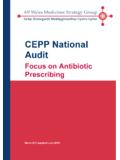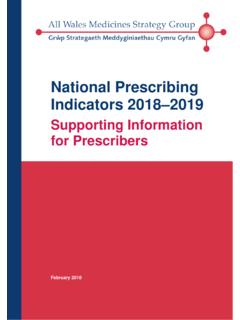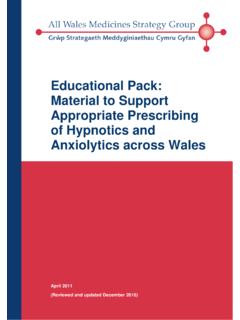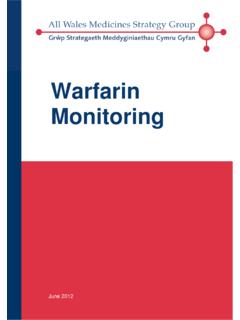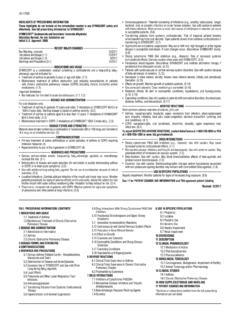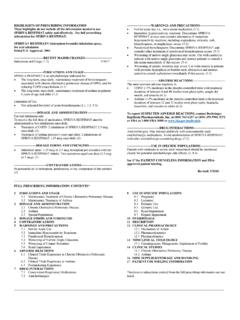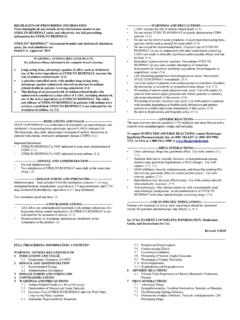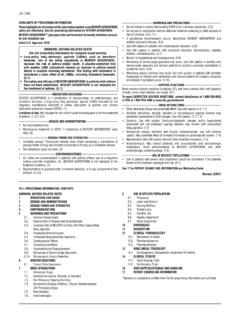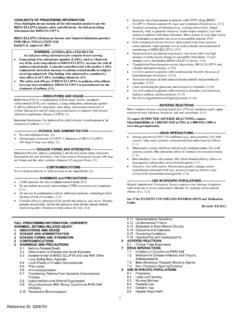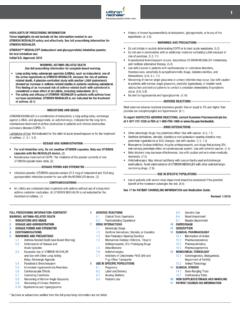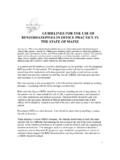Transcription of Polypharmacy: Guidance for Prescribing - AWMSG
1 polypharmacy : Guidance for Prescribing Supplementary Guidance . BNF Sections to Target July 2014. This Guidance has been prepared by Emyr Jones, Macmillan Palliative Care Pharmacist, Aneurin Bevan University Health Board and Jenny Pugh-Jones, Head of Medicines Management, Hywel Dda University Health Board, with support from the All Wales Prescribing Advisory Group (AWPAG) and the All Wales Therapeutics and Toxicology Centre (AWTTC), and has subsequently been endorsed by the All Wales Medicines Strategy Group ( AWMSG ). Please direct any queries to AWTTC: All Wales Therapeutics and Toxicology Centre University Hospital Llandough Penlan Road Llandough Vale of Glamorgan CF64 2XX.
2 029 2071 6900. This document should be cited as: All Wales Medicines Strategy Group. polypharmacy : Guidance for Prescribing . Supplementary Guidance BNF Sections to Target. July 2014. polypharmacy Supplementary Guidance BNF Sections To Target CONTENTS. GASTRO-INTESTINAL SYSTEM .. 2. Proton pump inhibitors .. 2. Laxatives .. 2. Antimotility medicines .. 3. CARDIOVASCULAR SYSTEM .. 3. Anti-anginal medication .. 3. Antiplatelets .. 3. Anticoagulants .. 4. Antihypertensives .. 6. Digoxin .. 6. Amiodarone .. 7. Diuretics .. 7. Lipid-modifying drugs .. 7. Peripheral vasodilators and oxerutins .. 8. RESPIRATORY SYSTEM .. 8. Short-acting beta 2 agonists .. 8.
3 Inhaler devices and technique .. 8. Corticosteroids in COPD .. 9. Corticosteroids in asthma .. 9. CENTRAL NERVOUS SYSTEM .. 9. Anticholinergics .. 9. Antidepressants .. 10. Treatment of vertigo .. 11. Antipsychotics for behavioural and psychological symptoms of dementia .. 11. Hypnotics and anxiolytics .. 12. Metoclopramide and 13. Opioid analgesics .. 13. INFECTIONS .. 14. Antibiotics .. 14. Topical preparations .. 14. ENDOCRINE SYSTEM .. 15. Antidiabetic agents .. 15. Home blood glucose monitoring for type II diabetics .. 16. Long-term oral 16. Bisphosphonates .. 16. Strontium ranelate .. 17. UROGENITAL SYSTEM .. 18. Antimuscarinics .. 18. Alpha-blockers.
4 18. Finasteride .. 18. NUTRITION AND 18. Calcium and vitamin D preparations .. 18. Vitamins and minerals .. 19. Nutritional supplements .. 19. MUSCULOSKELETAL SYSTEM .. 19. Non-steroidal anti-inflammatory drugs .. 19. MISCELLANEOUS .. 21. Quinine .. 21. Antihistamines .. 21. Risks of common sodium-containing oral medicines .. 21. Shared care 21. Medicines prescribed by secondary 21. Specialist services .. 22. Unlicensed pharmaceutical specials .. 22. Medicines or preparations purchased over the counter .. 22. REFERENCES .. 23. Page 1 of 27. All Wales Medicines Strategy Group GASTRO-INTESTINAL SYSTEM. Proton pump inhibitors Proton pump inhibitors (PPIs) have been associated with Clostridium difficile, pneumonia, bone fractures and hypomagnesaemia.
5 Consider reducing the dose or stopping, especially if antibiotics are required due to increased risk of C. difficile. Points for consideration: Use lowest possible dose to achieve desired therapeutic effect. Consider when required' use. Step patients down and stop where possible (with the exception of long-term indications for treatment such as Barrett's oesophagus/on specialist advice)1. Co-prescribed clopidogrel? Medicines and Healthcare products Regulatory Agency (MHRA) Drug Safety Update (2010) advises that the use of either omeprazole or esomeprazole with clopidogrel should be discouraged due to reduced antiplatelet effect. Current evidence does not support extending this advice to other PPIs.
6 Patients at risk of gastro-intestinal (GI) adverse effects co-prescribed a non- steroidal anti-inflammatory drug (NSAID) should be co-prescribed a PPI. Risk factors for GI adverse effects include2;. Use of maximum dose NSAIDs Aged 65 years History of gastroduodenal ulcer, GI bleeding, or gastroduodenal perforation Concomitant use of medicines known to increase upper GI adverse events ( anticoagulants, aspirin [including low dose], corticosteroids, selective serotonin reuptake inhibitors [SSRIs], venlafaxine, duloxetine . see current British National Formulary [BNF] for full list). Serious co-morbidity ( cardiovascular disease [CVD], hepatic/renal impairment, diabetes).
7 Prolonged NSAID use (including patients with osteoarthritis or rheumatoid arthritis at any age and chronic low back pain in patients . 45 years). The following AWMSG educational pack aims to support the appropriate Prescribing of PPIs by providing a practical approach for the initiation and review of PPI Prescribing : %20and%20 Dyspepsia%20 Resource% Laxatives Avoid long-term prescriptions where possible and review regularly. Points for consideration: Check dose and choice of laxative. Treatments should be selected from available options and reflect patient preference, severity, type and duration of symptoms (see AWMSG Common Ailment Service Formulary).
8 Start with an osmotic laxative macrogol (Laxido ) or a bulk-forming laxative ispaghula husk (Fybogel ) (ensure adequate fluid intake with both). Bulking agents, ispaghula husk, are less suitable in patients with limited mobility, bedbound, and can take up to two weeks to be effective; therefore, stimulant laxatives senna should be considered first-line in this group3. Consider adding a stimulant laxative if stools are soft but difficult to pass or emptying is inadequate. Page 2 of 27. polypharmacy Supplementary Guidance BNF Sections To Target Prescribed two laxatives from the same class, lactulose and macrogol are both osmotic laxatives consider review.
9 Reduce overuse of laxatives if possible. If more than one laxative is used, reduce and stop one at a time. Reduce stimulant laxative first, increasing the dose of osmotic laxative if necessary. Consider discontinuation of laxatives if: Previous opioid use has reduced/stopped Regular bowel movements occur without difficulty Patient is eating/drinking with an adequate fluid intake Review medicines that commonly cause constipation opioids, verapamil (also other calcium channel blockers (CCBs) to a lesser extent), tricyclic antidepressants (TCAs), iron, diuretics, aluminium antacids, calcium, anticholinergics, sedating antihistamines etc. Advice regarding the non-pharmacological management of constipation can be found at: #!
10 Scenariorecommendation:4. Use of dantron (as co-danthramer or co-danthrusate) is limited by potential carcinogenicity and evidence of genotoxicity. Dantron should ONLY be used to manage constipation in terminally ill patients1. Liquid paraffin should not be used long term; associated with anal seepage of paraffin and consequent anal irritation with prolonged use2. Antimotility medicines Consider potential for antimuscarinic side effects with co-phenotrope (medicine considered less suitable for Prescribing by BNF)2. Loperamide may be a more appropriate alternative. CARDIOVASCULAR SYSTEM. Anti-anginal medication Points for consideration: Consider reducing anti-anginal medication particularly if mobility has decreased with less need for medication4.
